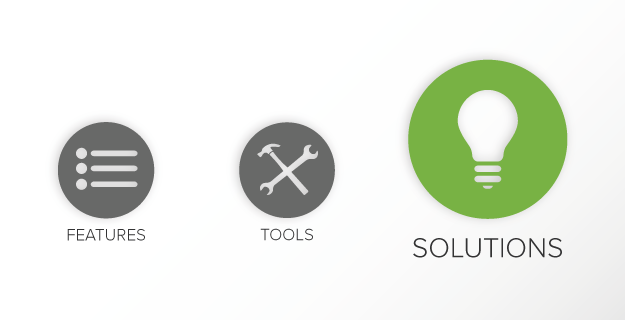
Trying to choose a technology solution? If you have features on your mind, you may have it all wrong. Read on for some ideas for a more productive way to think about evaluating technology solutions.
Choosing a technology solution is difficult, and it is very tempting to look at feature lists, whether you are looking at a product in isolation, or comparing two or more products against each other. However, a long list of impressive-sounding features will not guarantee the product will be a success in your organization and with your users (and often, a long list of features may mean quite the opposite, in fact!). To reach clarity on a better way to think about choosing a technology product, let’s take a closer look at features first…
Features, Redefined
A feature is simply a characteristic of a product or service; it is not something positive in its own right. If you think of a benefit as a solution to a specific need, certain features within a product will simply not be of benefit to you as they do not provide the solution to a problem that you or your users have. Features should offer benefits, but they do not necessarily do so for all users. Just as successful selling focuses on benefits and not features, so too does successful product evaluation.
A Problem Is Essential for a Solution
The first thing to look at is your business problem, considering tools and their features through the lens of whether they are capable of solving this problem.
Just as our product was built with problem-solving in mind – rather than assembling a set of features without a thought for their practical application – when we are looking for technology solutions internally, we always think about specific business problems we have, and how we can find a solution to them. Whilst I believe that solution-based buying – and, indeed, selling – should be the norm, it seems that evaluating these through the lens of feature lists is still all-too-common.
My colleague, Jana Rhyu, discussed this in her recent post on presenting at Dreamforce, explaining our use of Salesforce as a solution rather than a tool. She notes that finding a tool is one piece of the puzzle, but understanding the business requirements and how the tool can map to those requirements is crucial, and is the element that transforms a tool into a solution. Indeed, it doesn’t matter how rich the feature set is, you need to evaluate features in relation to their usefulness as part of a solution. Furthermore, Jana states that, “A solution is only a solution if it solves problems you face. If not, it is just a tool with a feature list – and in my experience, this will not drive real results.”
Defining Success for the Technology Solution
Keep in mind that choosing a new product is often part of a greater business project, with multiple stakeholders involved. Before embarking on a project, you need to define what success looks like for these multiple stakeholders, in addition to having worked out what your business problems are. For example, success to procurement may mean finding a product which saves your company a certain percentage of your current spend, but that same product may not satisfy other stakeholders’ requirements such as available support for the product or ease of use. The requirements for one stakeholder need to be balanced against what success looks like for other stakeholders.
This insightful article about UC strategies in InformationWeek, authored by Erika Van Noort, looks at this issue. Erika explains the importance of not just looking at technology, but carefully considering company culture and actual use case when evaluating products. She explains that figuring out what a ‘solution’ is involves knowing how success is being defined for multiple stakeholders, and not just about knowing what your business problems are. So, a successful solution will actually solve multiple problems.
Don’t Forget the Users
In the article above, Erika notes that many products fail at companies because the users have not been carefully considered enough. The amount of training required should always be a consideration, and so choosing a product that is more intuitive and easier for users will require less training, which will be helpful for increasing adoption, and therefore the success of the product internally. Of course you need an appropriate set of features which fulfill your users’ needs, but crucially these features need to be presented intelligently with usability in mind.
Closing Thoughts
So, it seems clear that looking at features in a vacuum is not enough. Instead, you need to really understand the business problems you wish to solve, as well as being clear about how success will be defined, and making sure the product you choose is easy enough to use that your users will actually adopt it. It’s a tall order, but highly rewarding when you find a solution that works for you and your users.
Do you have any other tips for choosing technology solutions?
For more posts on technology solutions, check these out:
3 business apps which solve problems
Video Conferencing Continues to Struggle: The Overlooked – and Perhaps Biggest – Reason Why
From Tool to Solution: Presenting at Dreamforce on the Ultimate Puzzle









